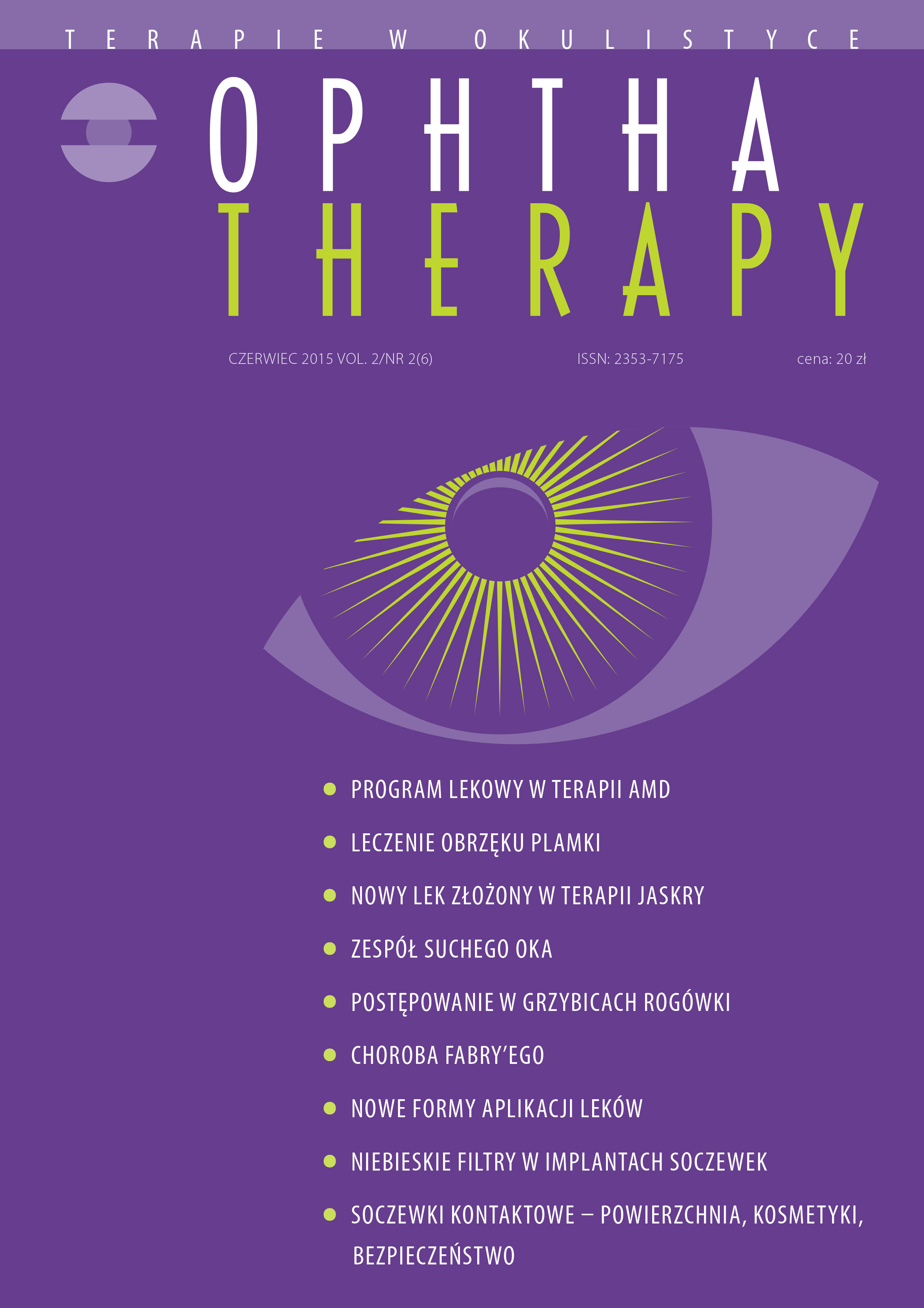Znaczenie filtra światła niebieskiego w soczewkach wewnątrzgałkowych stosowanych w chirurgii zaćmy
##plugins.themes.bootstrap3.article.main##
Abstrakt
Promieniowanie światła niebieskiego jako czynnik fototoksyczny może prowadzić do poważnego uszkodzenia siatkówki ludzkiego oka. W niniejszym artykule przedstawiono znaczenie filtra światła niebieskiego w soczewkach wewnątrzgałkowych stosowanych w chirurgii zaćmy na podstawie aktualnych publikacji i badań klinicznych. Omówiono ważne aspekty dotyczące wpływu żółtych soczewek na ochronę siatkówki, z uwzględnieniem pacjentów narażonych na rozwój zwyrodnienia plamki żółtej (AMD, age-related macular degeneration) i proliferację komórek melanoma. Przedstawiono wpływ soczewek z filtrem światła niebieskiego na regulację rytmów okołodobowych, widzenie barwne, skotopowe, poczucie kontrastu oraz efekt blasku i olśnienia
Pobrania
##plugins.themes.bootstrap3.article.details##

Utwór dostępny jest na licencji Creative Commons Uznanie autorstwa – Użycie niekomercyjne – Bez utworów zależnych 4.0 Międzynarodowe.
Copyright: © Medical Education sp. z o.o. License allowing third parties to copy and redistribute the material in any medium or format and to remix, transform, and build upon the material, provided the original work is properly cited and states its license.
Address reprint requests to: Medical Education, Marcin Kuźma (marcin.kuzma@mededu.pl)
Bibliografia
2. Bullough J. The blue light hazard: A review. Journal of the Illuminating Engineering Society. 2000; (29)2: 6-14.
3. Weale R. Age and the transmittance of the human crystalline lens. J Physiology. 1988; 395: 577-87.
4. Miyake K, Ichihashi S, Shibuya Y et al. Blood-Retinal Barrier and Autofluorescence of the Posterior Polar Retina in Long-Standing Pseudophakia. Journal Cataract Refract Surg. 1999; 25(7): 891-7.
5. Sparrow JR, Miller AS, Zhou J et al. Blue light – absorbing intraocular lens and retinal pigment epithelium protection in vitro. J Cataract Refract Surg. 2004; 30(4): 873-8.
6. Rezai K, Gasyna E, Seagle BL et al. AcrySof Natural filter decreases blue light-induced apoptosis in human retinal pigment epithelium. Graefe’s Arch Clin Exp Ophthalmol. 2008; 246(5): 671-6.
7. Yanagi Y, Inoue Y, Iriyama A et al. Effects of yellow intraocular lenses on light-induced upregulation of vascular endothelial growth factor. J Cataract Refract Surg. 2006; 32(9): 1540-4.
8. Kernt M, Nubauer AS, Liegl R et al. Cytoprotective effects of a blue light-filtering intraocular lens on human retinal pigment epithelium by reducing phototoxic effects on vascular endothelial growth factor-alpha, Bax, and Bcl-2 expression. J Cataract Refract Surg. 2009; 35(2): 354-62.
9. Obana A, Tanito M, Gotho Y et al. Macular pigment changes in pseudophakic eyes quantified with resonance Raman spectroscopy. Ophthalmology. 2011; 118(9): 1852-8.
10. Nolan J, O’Reilly P, Loughman J et al. Augmentation of macular pigment following implantation of blue light filtering intraocular lenses at the time of cataract surgery. Invest Ophthalmol Vis Sci. 2009; 50(10): 4777-85.
11. Pipis A, Touliou E, Pillunat LE et al. Effect of the blue filter intraocular lens on the progression of geographic atrophy. Eur J Ophthalmol. 2015; 25(2): 128-33.
12. Marshall JC, Gordon KD, McCauley CS et al. The effect of blue light exposure and use of intraocular lenses on human uveal melanoma cell lines. Melanoma Res. 2006; 16(6): 537-41.
13. Urban E, Misiuk-Hojło M, Kasprzak-Smolarek P et al. Circadian Rhythms and Organ of Sight. Silesian Piasts University of Medicine in Wroclaw. Adv Clin Exp Med. 2006; 15(5): 953-7.
14. La Morgia C, Ross-Cisneros FN, Sadun AA et al. Melanopsin retinal ganglion cells are resistant to neurodegeneration in mitochondrial optic neuropathies. Brain. 2010; 133: 2426-38.
15. Kessel L, Lundeman JH, Herbst K et al. Age-related changes in the transmission properties of the human lens and their relevance to circadian entrainment. J Cataract Refract Surg. 2010; 36: 308-12.
16. Birren J, Casperson RC, Botwinck J et al. Age changes in pupil size. J Gerontol. 1950; 5(3): 216-21.
17. Alexander I, Cuthbertson FM, Ratnarajan G et al. Impact of Cataract Surgery on Sleep in Patients Receiving Either Ultraviole-Blocking or Blue-Filtering Intraocular Lens Implants. Invest Ophthalmol Vis Sci. 2014; 55(8): 4999-5004.
18. Brøndsted A, Lundeman JH, Kessel L et al. Short wavelength light filtering by the natural human lens and IOLs – implications for entrainment of circadian rhythm. Acta Ophthalmol. 2013; 91(1): 52-7.
19. Rodríguez-Galietero A, Montés-Micó R, Muñoz G et al. Comparison of contrast sensitivity and color discrimination after clear and yellow intraocular lens implantation. J Cataract Refract Surg. 2005; 31(9): 1736-40.
20. Augustin AJ. The physiology of scotopic vision, contrast vision, color vision, and circadian rhythmicity: can these parameters be influenced by blue-light-filter lenses? Retina. 2008; 28(9): 1179-87.
21. Hammond B Jr, Renzi Lm, Sachak S et al. Contralateral comparison of blue-filtering and non-blue-filtering intraocular lenses: glare disability, heterochromatic contrast, and photostress recovery. Clin Ophthalmology. 2010; 4: 1465-73.

